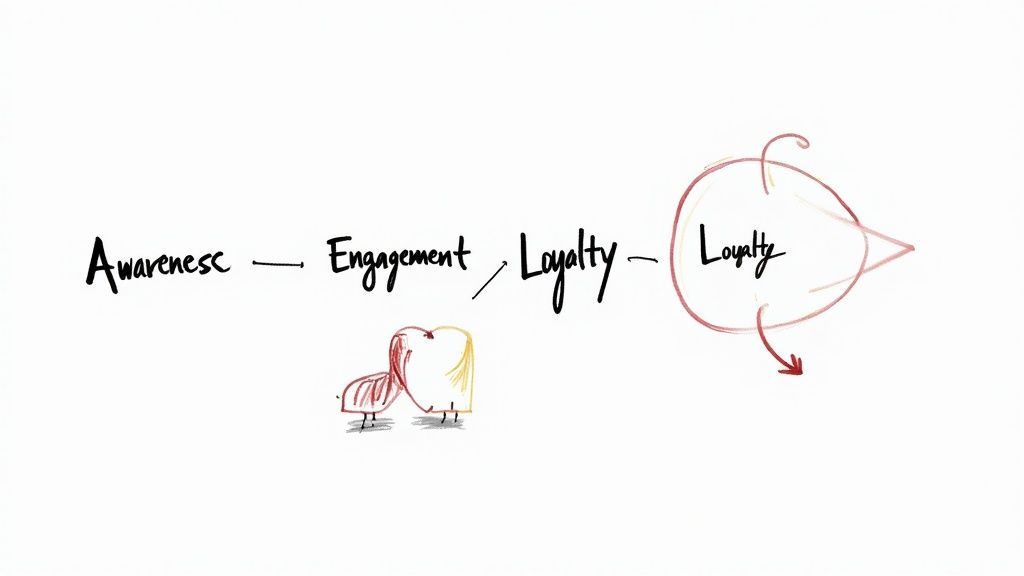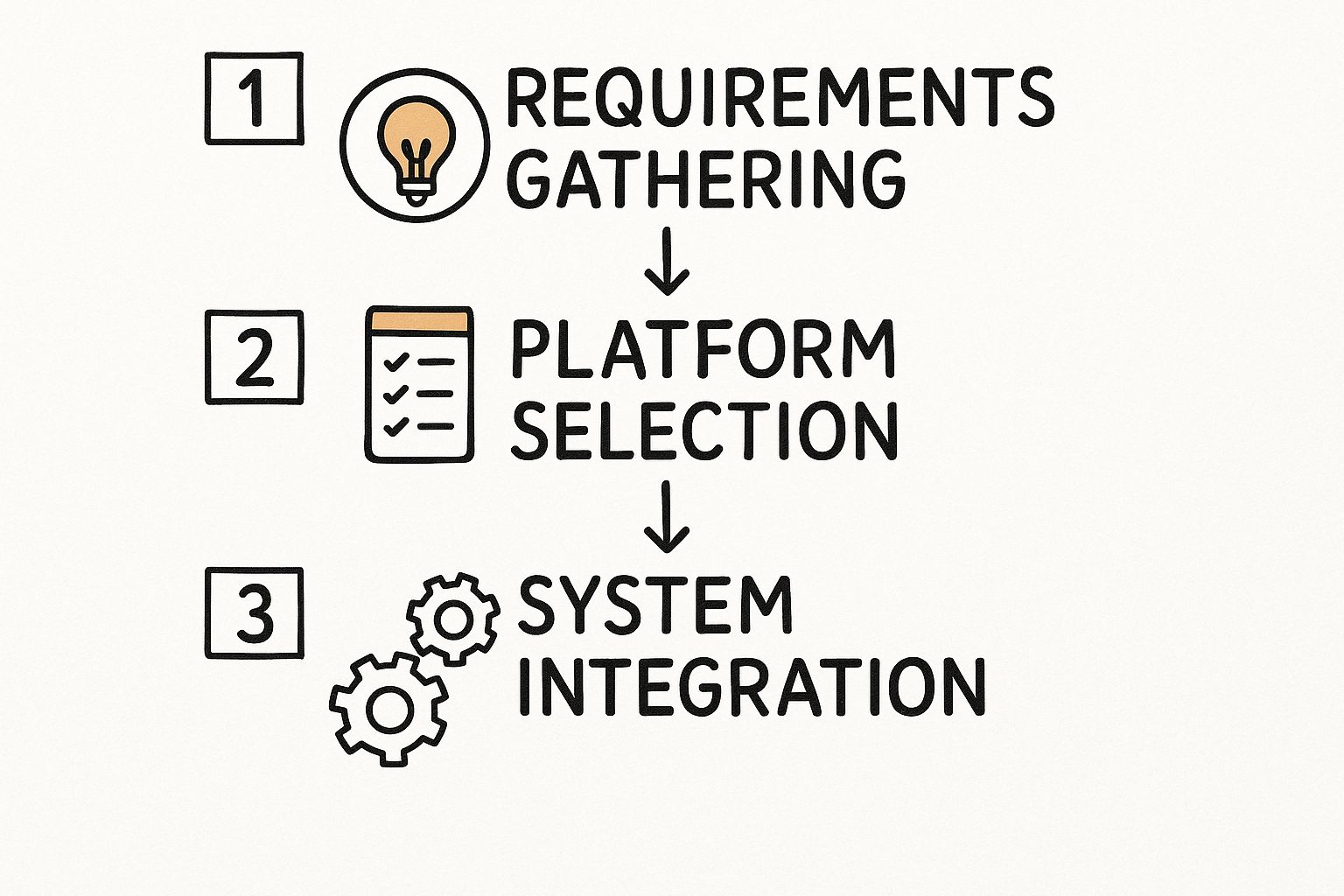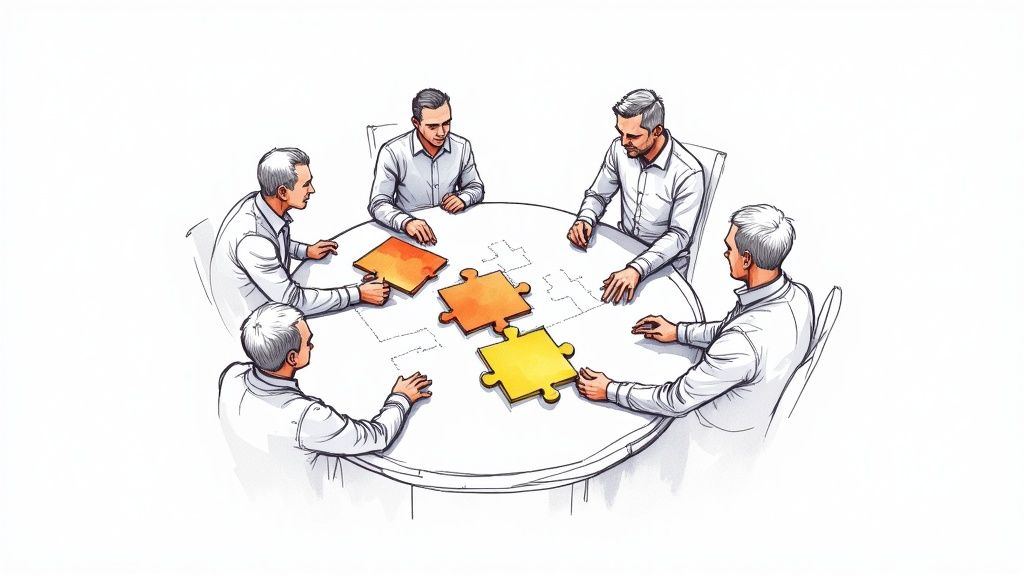Let's be honest, when people hear "CRM," they usually think of software. A dashboard, a contact list, a sales pipeline. But that's only half the story. A true customer relationship management strategy, or CRM strategy, is the game plan behind the technology. So, what is a crm strategy?
It's the blueprint that dictates how your sales, marketing, and customer service teams actually use that software and all the data within it. The whole point is to build real, profitable, and long-lasting strategic customer relationships. This strategy makes sure every single customer relationship crm interaction—from the first ad they see to the support ticket they submit a year later—feels consistent, personal, and moves you closer to your business goals.
The Foundation of Strategic Customer Relationships

Here's a classic mistake: a company invests in a powerful CRM platform, thinking they've checked the "customer relationship" box. But in reality, the software is just a tool. It’s a very capable tool, but a tool nonetheless.
Without a solid CRM strategy guiding it, that fancy platform is just a glorified digital address book. An expensive one at that.
Think of it like this: your CRM software is a top-of-the-line race car. Your customer relationship management strategy is the driver who knows the track, the GPS mapping out the fastest route, and the pit crew keeping everything running smoothly. It tells you where you're going (your goals), the best way to get there (your processes), and who's responsible for what along the way. Your success isn't about the car; it's about how you drive it.
So, What's a CRM Strategy Actually For?
At its heart, building a client relationship management strategy is about making a fundamental shift. You move from just thinking about one-off transactions to focusing on building genuine, long-term relationships. It’s a formal plan that details how your business will find, win, and keep customers—and then, how you'll help them grow with you. Wondering what are crm strategies? They are the specific actions and processes that bring this plan to life.
A well-crafted strategy makes sure every piece of the puzzle fits together perfectly. It’s all about creating a seamless and positive experience for your customer, no matter where they are in their journey.
To get more specific, a good plan has a few core components. The table below breaks down the main pillars you'll want to build your strategy around.
Core Pillars of a Modern CRM Strategy
Ultimately, these pillars work together to turn a simple contact list into a powerful engine for growth.
Why Every Business Needs This Strategic Framework
Trying to grow without a CRM strategy is like trying to build a house without a blueprint. It’s chaotic. Teams end up working in silos, leading to clunky customer experiences and tons of missed opportunities. The success of crm depends on this framework.
Imagine your marketing team runs a huge promotion, but the sales team has no idea it’s happening. Or a customer service agent is talking to an unhappy client but can't see their long purchase history or previous support issues. These are the kinds of problems that a CRM strategic framework solves.
It's not just a "nice-to-have." A well-defined marketing strategy and CRM integration can lead to a 300% improvement in lead conversion rates. That's the power of turning raw data into smart, coordinated action.
This organized approach is critical for any business, no matter the size. While many articles about customer relationship management get bogged down in software features, a successful setup always starts with a clear plan.
If you want to get into the nitty-gritty of the tech itself, our guide on what a CRM system is can help. But remember, the software is just the vehicle. Your CRM strategic framework is what allows you to stop reacting to customer issues and start proactively anticipating their needs, building the kind of strategic customer relationships that last.
Setting Meaningful CRM Goals for Your Business
Let's be honest. Rolling out a new CRM without a clear destination is like setting sail without a map. Sure, you're moving, but are you getting any closer to where you actually want to be? The success of crm for your entire customer relationship management strategy hinges on setting clear, actionable, and measurable goals from the very beginning.
Simply saying you want to "improve customer relationships" isn't going to cut it. A powerful crm strategy takes those vague ambitions and translates them into tangible business outcomes. This is about defining specific targets that line up perfectly with your company's bigger growth plans.
Moving Beyond Generic Targets
Effective customer relationship management goals aren't fuzzy—they're specific and you can put a number on them. They give you a benchmark for success and make sure every team, from sales and marketing to customer service, is pulling in the same direction. Without these targets, your efforts get messy and your investment in CRM tech might not deliver any real return.
Think of it this way: your main business objective might be to grow annual revenue. A solid client relationship management strategy breaks that massive goal down into smaller, bite-sized goals that different teams can take ownership of.
A well-defined strategy transforms your CRM from a passive database into an active tool for growth. Instead of just storing information, it becomes a system for achieving specific outcomes, such as boosting lead conversion rates by 20% or reducing customer churn by 15%.
These numbers aren't just pulled out of a hat; they are the concrete results that define a successful CRM rollout. When you're developing a crm plan with these kinds of objectives, you create a clear roadmap for everyone to follow.
Examples of Department-Specific CRM Goals
A truly effective relationship management model makes sure every department plays its part in the grand vision. Your marketing, sales, and service teams might have different day-to-day tasks, but their CRM goals should lock together to create a seamless experience for the customer.
Here are a few crm strategy examples for different departments to get you thinking:
For Your Sales Team
The sales department is often the first to feel the impact of a strong customer relationship management sales focus. For them, it’s all about working smarter, not harder. This is a core part of sales customer relationship management.
- Reduce the average sales cycle length by 25% by using CRM automation for follow-ups and task management.
- Increase the lead-to-opportunity conversion rate by 20% by using lead scoring and digging into detailed contact histories.
- Improve sales forecast accuracy to 90% by making sure all reps consistently update deal stages and values right inside the CRM.
For Your Marketing Team
For the marketing crew, a crm and marketing strategy is all about personalization and proving ROI. That CRM data is a goldmine for crafting campaigns that actually hit the mark. This is where marketing and customer relationship management truly merge.
- Boost marketing-qualified lead (MQL) to sales-qualified lead (SQL) conversion by 30% by building better, automated lead nurturing flows.
- Increase customer lifetime value (CLV) by 15% by creating personalized upsell and cross-sell campaigns based on what people have already bought.
- Improve email campaign open rates by 10% by segmenting audiences based on their engagement history and preferences stored in the CRM.
For Your Customer Service Team
We all know that top-notch service is the key to keeping customers around. A service-focused customer management strategy is all about solving problems quickly and proactively.
- Decrease average ticket resolution time by 30% by giving agents a 360-degree view of a customer's history.
- Improve the first-contact resolution rate to 85% by giving the team a knowledge base that’s integrated right into the CRM.
- Boost the Customer Satisfaction (CSAT) score by 20 points using post-interaction surveys triggered automatically by the CRM.
Nailing down these goals is the single most important step in developing crm capabilities. It gives your team the "why" behind every click and every call. For a deeper dive into the metrics your sales team should be tracking, our guide on sales key performance indicators is a great place to start. In the end, setting clear objectives ensures the success of crm isn't left to chance—it's the direct result of a plan well-executed.
Building Your Strategic CRM Framework
Once you’ve nailed down your goals, it's time to build the structure that will actually support them. A solid customer relationship management strategy needs an architecture—a blueprint that maps out how every part of your business touches the customer. This CRM strategic framework is what turns your big-picture vision into a process you can repeat and scale.
Think of it like building a house. Before you start decorating the rooms (running campaigns) or inviting people over (engaging customers), you have to be sure the foundation is solid. This means mapping out every interaction, being disciplined with your data, and getting your people and technology all pointed in the same direction. This is where you start improving customer relationship management for real.

Map Every Customer Touchpoint
First things first: you need to walk a mile in your customer's shoes. The best way to do this is with a customer journey map, which is just a visual story of every single interaction someone has with your company. It starts the moment they first hear about you and follows them all the way to becoming a loyal fan.
Mapping this journey is a game-changer. It shines a light on friction points you never knew existed and uncovers opportunities to make someone's day. The process forces you to answer some key questions:
- Awareness: How do people even find out we exist? (Social media? A customer relationship management blog post they stumbled on? An ad?)
- Consideration: What do they look at when they're kicking the tires? (Pricing pages, case studies, demos?)
- Purchase: What’s it actually like to buy from us? Is it a breeze or a headache?
- Service: What happens after we get their money? Is getting help easy and painless?
- Loyalty: What are we doing to earn their repeat business and get them talking to their friends?
When you understand these touchpoints, your customer relationship strategies can finally become proactive instead of just reactive. A huge piece of this is creating a seamless experience everywhere, which is why an omnichannel customer service approach is so critical.
Master Your Data Management
Let's be blunt: your CRM is only as good as the data you put into it. A disciplined approach to data is completely non-negotiable for any serious client relationship management strategy. This isn't just about collecting information; it's about making sure that data is clean, organized, and ready to be used.
Bad data can sabotage even the most brilliant crm strategies. It leads to cringe-worthy personalization mistakes and business insights that are flat-out wrong. Your customer relationship management framework has to put data quality front and center:
- Clean Data Collection: Set up clear, standardized rules for how to crm data gets into the system. This is your first line of defense against duplicates and messy records.
- Smart Segmentation: Group your customers based on things they have in common—what they've bought, how often they engage, or their demographic info. This is the bedrock of any marketing CRM strategy that actually works.
- Data Enrichment: Look into tools that can automatically update and add missing info to your contacts. This keeps your database fresh and gives you a much richer picture of who you're talking to. Speaking of which, a deep understanding of your contacts is essential for lead scoring, something we cover in our guide to lead scoring to help you focus your sales team's energy where it counts.
Align Technology and People
Technology is a massive enabler, but it's the people using it who really determine the success of CRM. Your framework has to account for both the tool and the team. A classic mistake is picking a fancy CRM platform and then trying to cram your existing processes into its rigid boxes.
Here's the golden rule for picking tech: Your CRM platform should bend to fit your business processes, not the other way around. Choose a tool that supports the customer journey you've already mapped out, not one that forces you to change it.
This people-first mindset also means defining who does what. Everyone on the team needs to know their exact role in the customer relationship management framework. This demands great training—not just on how to click the buttons, but on why it all matters for hitting your shared goals.
This alignment is absolutely fundamental when implementing CRM strategy. The market's explosive growth underscores this point; the global CRM software market hit about $101.4 billion in 2024 and is projected to soar to $262.74 billion by 2032 as more companies finally get serious about putting customers first.
Implementing Your CRM Strategy Step-by-Step
Alright, you've got a solid framework in place. Now it's time to shift from planning to doing. Implementing a CRM strategy isn't a race; it's a methodical process. You need careful coordination to weave new processes and tech into your daily operations without tripping up your teams. This guide covers implementing customer relationship management from start to finish.
Think of it as a phased rollout that manages complexity and builds momentum. This flow gives you a clear roadmap for the critical early stages, from figuring out your needs to getting the technology integrated.

This visual really drives home the point that a successful implementation starts long before anyone logs into the software. The real foundation for success is rigorous preparation.
1. Assemble Your Implementation Team
First things first: you need a dedicated team to own this project. This shouldn't be a siloed group. Pull in representatives from sales, marketing, customer service, and IT. Their mission is to steer the ship, make the tough calls, and ensure the customer relationship management strategy actually works for the people who will use it every day.
This crew will be on the hook for defining requirements, vetting software, and, most importantly, getting everyone else on board. Getting buy-in from key players across the business is your first real step toward a successful CRM launch.
2. Audit and Refine Current Processes
You can't fix what you don't understand. Before you even think about new tech, take a hard look at your current sales, marketing, and service workflows. Where are the bottlenecks? What’s redundant? Where do handoffs and communication break down?
This audit gives you a clear "before" picture, which is essential for designing new, smarter processes inside the CRM. It ensures your CRM strategy is solving real-world problems instead of just putting a digital wrapper on bad habits. This is your chance for improving customer relationship management from the ground up, and learning how to improve crm.
3. Select the Right CRM Software
The CRM market is absolutely massive and it’s still growing like crazy. In fact, between 2024 and 2030, the global CRM market is expected to more than double, blowing past $144 billion. With over 85% of new rollouts happening on cloud platforms, the game is all about flexible, scalable solutions.
Your choice should be guided by the goals you’ve already set and the processes you’ve mapped out.
- Functionality: Does the software actually do what your teams need it to do?
- Scalability: Can it grow with you, or will you be shopping for a new one in two years?
- Integration: How well does it play with the other tools you rely on, like your email or marketing automation platform?
- Usability: Is the interface intuitive? If your team hates using it, they just... won't.
Don't rush this. Take your time with demos and free trials. For a deep dive into what to look for, check out our guide on essential CRM software features. This decision becomes the technical backbone of your entire relationship management strategy.
4. Configure the Platform and Migrate Data
Once you’ve picked your software, the real technical work begins. This is where you customize the platform to fit your refined business processes—that means setting up sales pipelines, creating custom fields for the data that matters to you, and defining who gets to see and do what.
Then comes data migration. This is the delicate process of moving all your existing customer info into the new system. Clean data is everything for the success of CRM. Use this as a chance to merge duplicate contacts and get rid of outdated or just plain wrong information. A clean data migration ensures your team trusts the system from day one.
A CRM system is only as reliable as the data within it. A "garbage in, garbage out" approach during migration can undermine the entire strategy before it even launches. Prioritizing data hygiene is non-negotiable.
5. Train Your Team and Drive Adoption
The tech is just a tool; your people are what make it powerful. User adoption is the single biggest factor that will make or break your CRM strategy. Don't treat training as a one-and-done event—it needs to be an ongoing process.
Focus your training on the "why" behind the strategy, not just the "how" of clicking buttons. Show your team exactly how the CRM will make their jobs easier and help them hit their targets. While you're at it, think about how automation can improve customer interactions. Learning how to strategically build effective chatbots can be a great way to enhance your digital engagement efforts.
To get the ball rolling on adoption, start with a pilot group of enthusiastic users, celebrate early wins publicly, and make sure continuous support is available. Follow these customer relationship management recommendations, and you'll turn a daunting project into a manageable—and successful—initiative.
Real-World CRM Strategy Examples
Theory is great, but seeing a CRM strategy example in the wild is what really makes it click. Abstract ideas like "improving customer relationships" don't mean much until you see how real companies put them to work. These customer relationship management success stories aren't just for inspiration; they're practical blueprints for what a solid customer relationship strategy can do for you.
Let's break down two very different CRM strategy examples—one from a B2B tech company and another from a B2C e-commerce brand—to see how the same principles adapt to totally different worlds.

B2B Tech Company Managing a Complex Sales Cycle
Picture a mid-sized SaaS company selling enterprise software. They were facing a classic B2B headache: a long, messy sales cycle. Deals were taking six to nine months to close and involved a whole cast of characters, making it nearly impossible for the sales team to keep deals moving and guess what might actually close. This is a common challenge for relationship management sales.
Their old way of doing things was pure chaos. Critical info was buried in spreadsheets and random email threads. This siloed approach meant qualified leads were falling through the cracks and sales forecasts were basically just wishful thinking. The root of the problem? A total lack of strategic customer relationship management.
The company set a clear goal: cut the sales cycle by 20% and get forecast accuracy above 90% within one year of launching their new CRM strategy.
To hit these numbers, they built their entire customer relationship management sales strategy around pipeline visibility and smart automation. Here’s what they did:
- Automated Lead Nurturing: Their CRM strategy in marketing kicked off with automated email sequences for prospects at every stage of the funnel. This kept the conversation going without sales reps having to manually send every single email.
- Centralized Stakeholder Data: Every single touchpoint with anyone at a target company—from the CTO down to a project manager—was logged in the CRM. Suddenly, every salesperson had a full 360-degree view of the entire relationship.
- Deal Health Scoring: They set up the CRM to automatically score deals based on engagement. If a deal went quiet, it was flagged for immediate follow-up. This is a game-changing customer relationship management technique.
This wasn't just a small tweak; it completely overhauled their relationship management sales process. A year later, they had slashed their average sales cycle by 22% and hit 94% forecast accuracy, blowing past their initial goals.
B2C E-commerce Brand Driving Personalization at Scale
Now let’s look at a popular online fashion brand. They were getting lost in a sea of competitors. Their generic, "one-size-fits-all" email campaigns were getting ignored, leading to dismal engagement and a growing unsubscribe list. They desperately needed a marketing crm strategy that could make every shopper feel special. This is a classic strategic CRM example.
The big challenge was creating a personal touch for hundreds of thousands of customers to keep them coming back. Their existing system treated everyone the same—a fatal flaw in their customer management strategy.
Their fix was a CRM marketing strategy centered on hyper-segmentation and behavioral triggers. The main customer relationship management goals were to increase customer lifetime value (CLV) by 15% and crank up email click-through rates by 50%.
Here are some of the CRM techniques they put into play:
- Behavioral Segmentation: The CRM automatically grouped customers based on what they looked at, how often they bought, and what they left in their carts.
- Personalized Product Recommendations: Email campaigns were no longer generic. They dynamically pulled in products based on what a customer had previously bought or browsed.
- Post-Purchase Automation: After a sale, the CRM triggered a custom follow-up sequence. This included things like care tips for the item they bought and suggestions for other products that would complete the look.
This strategic CRM example is all about the power of data. By moving from shouting at the masses to having a one-on-one conversation, they didn't just meet their goals—they crushed them. They boosted CLV by 18% and saw a massive 70% jump in email clicks. That’s what successful customer relationship management looks like when marketing and CRM are working together perfectly.
How Do You Know if Your CRM Is Actually Working?
A strategy is only as good as the results it brings in. Once you’ve got your CRM up and running, you need a clear, no-fluff way to measure its impact. We’re not talking about guesswork here; this is about using hard data to prove your efforts are paying off and to make smarter moves down the road.
Tracking the right numbers—or key performance indicators (KPIs)—is what turns your CRM plan from a bunch of ideas into a data-driven engine for growth. It shines a light on what’s working, what’s a dud, and where you can tweak your approach for better results.
Key Sales Performance Indicators
For any sales team, the endgame is simple: close more deals, faster. A solid CRM setup should make a direct, noticeable difference in how efficiently and effectively your team operates.
Here’s what to watch:
- Sales Cycle Length: How long does it take to turn a fresh lead into a paying customer? If this number is shrinking, your CRM is doing its job helping reps push deals through the pipeline without friction.
- Lead Conversion Rate: What percentage of your leads are actually becoming qualified opportunities? An uptick here is a great sign that your CRM-powered nurturing and follow-up game is strong.
- Sales Forecast Accuracy: How close are your team's predictions to the actual revenue you pull in? Better accuracy means your data is clean and your pipeline management is becoming a well-oiled machine.
Essential Marketing Metrics
Marketing and sales need to be in lockstep for a business to really take off. Your CRM is the bridge between them, and you can measure its strength by looking at how well you’re attracting the right customers without blowing your budget. The best crm strategies in marketing are always measurable.
Keep an eye on these metrics:
- Customer Acquisition Cost (CAC): How much are you spending to bring a new customer on board? A successful CRM strategy should drive this number down by helping you target the best prospects with surgical precision.
- Marketing Campaign ROI: Are your marketing campaigns actually making you money? Your CRM should give you the data to draw a straight line from a specific campaign right to a closed deal.
- Customer Lifetime Value (CLV): This is the big one. It’s the total revenue a customer will generate throughout their entire relationship with you. A rising CLV is a core sign that your customer relationships are getting stronger, not just wider.
Customer Service Success Metrics
Great service doesn’t just solve problems; it turns one-time buyers into loyal fans who sing your praises. Your CRM should be your support team’s secret weapon, giving them what they need to resolve issues fast and keep people happy.
Look for improvements in:
- First-Contact Resolution Rate: What percentage of issues get solved in the very first interaction? A high rate here means your agents have all the customer history and information they need, right when they need it.
- Average Ticket Resolution Time: How long does it take to close out a support ticket? Faster times are a direct result of the streamlined, organized workflows your CRM should create.
- Customer Satisfaction (CSAT) / Net Promoter Score (NPS): These scores are a direct pulse check on customer happiness and loyalty. If these numbers are trending up, it’s one of the strongest signals that your CRM is having a massive impact.
A data-driven approach not only proves the value of your CRM strategy to stakeholders but also empowers you to make smarter, more agile decisions for future growth.
Don't just take our word for it. Organizations that bring AI into their CRM are 83% more likely to smash their sales targets. And with 70% of businesses now using mobile CRM platforms, it’s clear that accessibility is key—mobile users are 150% more likely to exceed their sales goals. If you want to dive deeper, you can discover more insights about these CRM statistics.
The best way to track all this is by using dashboards and reports to get a real-time view of what's happening. For a closer look at what these tools can do, check out our guide on creating powerful CRM reports.
Got Questions About CRM Strategy? We’ve Got Answers.
Diving into the world of customer relationship management kicks up a lot of questions. It’s one thing to talk about a plan, but another thing entirely to put it into action. Let's tackle some of the most common questions that pop up when teams start building out their customer relationship management strategy.
What’s the Real Difference Between CRM Software and a CRM Strategy?
This is a big one, and it’s a super common point of confusion when you’re just developing a crm plan.
Think of it this way: your CRM software is like a top-of-the-line sports car. It's the technology, the machine that’s packed with power to hold all your customer data and automate jobs. Your CRM strategy, on the other hand, is the roadmap, the GPS, and your driving instructor all rolled into one.
The strategy is the complete game plan for how you'll use that car to get where you want to go, whether that’s boosting sales or making customers so happy they never leave. You can't have a successful crm outcome with just one of them. The slickest software in the world is just a garage ornament without a solid customer relationship management strategy telling you how to drive it.
How Often Should We Actually Look at Our CRM Strategy?
A client relationship management strategy needs to be a living, breathing part of your business—not a dusty binder you create once and then shelve. Markets change, customer tastes shift, and your own business goals will naturally evolve. The best customer relationship management methods adapt over time.
As a rule of thumb, give your relationship management strategy a deep-dive review at least once a year. This keeps it locked in with your bigger business goals. On top of that, schedule quarterly check-ins to see how you’re tracking against your targets. This gives you the chance to make small tweaks and keep things sharp.
This rhythm ensures your strategies for customer relationship management stay relevant and don't end up gathering dust while the world moves on.
What Are the Biggest Roadblocks During Implementation?
When it comes to implementing customer relationship management, the toughest challenges are almost never about the tech itself. The real hurdles are usually about people and processes. The top three culprits are almost always:
- Low User Adoption: Let's be real—people get comfortable in their routines. If your team resists changing how they work and doesn't use the CRM consistently, the data becomes a mess. This is a common barrier to knowing how to improve crm customer relationship management.
- Garbage Data In, Garbage Data Out: If the information going into the CRM is wrong, incomplete, or full of duplicates, it’s basically useless. You can't make smart decisions with bad data.
- Flying Blind with No Goals: Kicking off an implementation without clear customer relationship management goals is like starting a road trip without a destination. You'll have no idea if you're making progress or measuring the success of crm.
Getting past these stumbling blocks takes strong leadership, great training, and a crystal-clear vision from day one.
Is a Formal CRM Strategy Overkill for a Small Business?
Absolutely not. You could argue that a formal crm strategy is even more important for a small business. When you're small, every single customer relationship counts for so much more. A strategy gives you a structured way to handle leads, build real connections with clients, and offer personalized service that lets you punch way above your weight. The right client relationship management model can be a small business's superpower.
A solid customer management strategy makes sure your limited time and money are spent on the things that actually move the needle. It stops good leads from slipping through the cracks and helps you get the most out of every client you have. For a small business, that’s not just nice to have—it’s the foundation for growth.
Ready to turn your strategy into reality with a platform built for growth? PlusVibe uses AI to power your outreach, helping you build stronger relationships and close more deals. See how our tools can elevate your customer engagement by visiting https://www.plusvibe.ai.














































.jpeg)


.png)























































